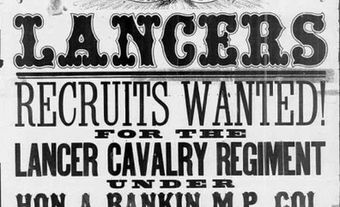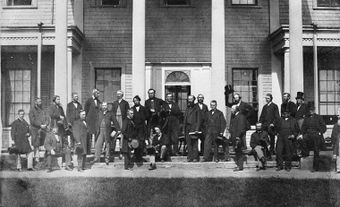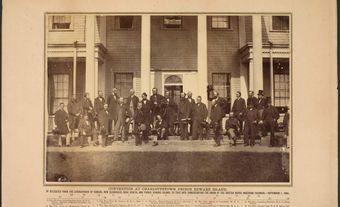In the third year of the American Civil War, around 20 Confederate agents raided the town of St. Albans, Vermont. The raid was planned by Confederate spymasters based in St. Catharines and Montreal. On 19 October 1864, the men robbed the town’s three banks and killed a man, before crossing the border into Canada. Fourteen of the raiders were soon arrested. They were brought to trial three times and released each time by Canadian judges. The raid and court decisions worsened relations between Canada and the US, which were already strained.

Background
The American Civil War began on 12 April 1861, pitting the northern (Union) states against southern (Confederate) states. As Britain declared its neutrality, the British colonies of Canada West and Canada East (now Ontario and Quebec) and the Atlantic colonies of Nova Scotia, New Brunswick, Prince Edward Island and Newfoundland were neutral as well.
By the fall of 1863, it was clear that the Confederate states were losing. In March 1864, Confederate president Jefferson Davis called upon former Mississippi congressman and federal secretary of the interior, Jacob Thompson. Jefferson asked Thompson to open a new, northern front of the war from Canada, where there were already hundreds of escaped Confederate prisoners of war, deserters and spies. The primary goal was to disrupt and distract the north and force American president Abraham Lincoln to withdraw some troops from southern battles to protect the northern border.
From his Toronto headquarters, Thompson oversaw initiatives that included attempts to capture American ships on the Great Lakes and to free Confederate prisoners of war. Thompson supported Lieutenant Bennett Young and Clement Clay, who led Confederate spy rings in St. Catharines and Montreal. Without Thompson’s knowledge, Bennett and Clay planned the St. Albans Raid.
Raid of St. Albans
Clay gave the 21-year-old Lieutenant Young $1,400 to finance a raid on St. Albans, Vermont, a town of several thousand people, located about 20 km south of the Canadian border. Young chose around 20 young Confederate soldiers for the mission. The men travelled in civilian clothes and arrived in St. Albans over the course of several days.
At three o’clock on Wednesday, 19 October 1864, they gathered at the town’s main square, where Young announced that St. Albans had been taken on behalf of the Confederacy. While some raiders gathered townspeople in the village green, others robbed $208,000 from the Franklin County Bank, the First National Bank of St. Albans, and the St. Albans Bank. They threw 50 bottles of Greek fire — chemical-based incendiary devices — at several buildings, but there were no major fires.
Meanwhile, cavalry officer Captain George Conger rallied a group of approximately 50 men, many of them civilians. Another group was organized and joined in pursuit of the raiders, who fled the town on stolen horses. During the action, one of the Confederate agents was wounded by gunfire. Elinus Morrison, visiting from New Hampshire, was shot and killed.
About 13 km north of St. Albans, the raiders split up. Although they reached the Canadian border, it wasn’t long before 14 were found and arrested.
Court Cases
American newspapers condemned the raid and criticized Canadian authorities for allowing Confederates to operate in Canada. Canadian papers criticized the Americans for illegally crossing the border in pursuit of the raiders.
On 25 October, the raiders were brought before police magistrate Charles-Joseph Courol at St. Johns (later Saint-Jean-sur-Richelieu), near the Vermont border. Their lead lawyer was John Abbott, who would later become Canada’s third prime minister. The defendants were charged with robbery, attempted arson, horse theft, assault, attempted murder, and murder. If sufficient evidence of their crimes could be presented, the judge could order them extradited to the United States to stand trial. After three days, the trial was moved to a more secure courthouse in Montreal, due to fears that American and Canadian supporters of the Confederate cause would disrupt proceedings.
On 14 December, the magistrate, Judge Charles J. Coursol, declared that he did not have the legal jurisdiction to hear the case. He ordered the defendants released and returned the money (approximately $87,000) that had been seized from them upon their capture.
Many American newspapers expressed outrage and called for war with Canada and Britain. Major General John Dix, the American commanding officer of the district, ordered troops to find the raiders even if it meant crossing the border. President Lincoln intervened, saying that he must approve any border incursions. The American Congress voted to end the treaty that limited the number and size of warships on the Great Lakes, as well as the Reciprocity Treaty, the American–Canadian free trade agreement.
On 20 December, Young and four other raiders were arrested and charged with robbing a man at one of the St. Albans banks. The hearing began in Montreal on 27 December but was adjourned to allow the defence to gather evidence. On 29 March, Superior Court Justice James Smith declared the raid an act of war, so he would not order extradition. The raiders were released again.
Once outside, Young and the others were rearrested, this time for violating Canada’s neutrality law. They appeared in a Toronto court on 11 April. Four raiders were discharged, and Young was released on a $10,000 bond. Meanwhile, the Canadian government reimbursed the banks in St. Albans for the money that had been returned to the raiders. In October 1866, John A. Macdonald (then attorney general for Canada West) decided not to charge Young, who was released from the bond. By then, the Civil War had been over for more than a year.
Significance
The raid and court decisions increased the already brittle relations between Canada and the United States while demonstrating the determination of Confederate agents to carry the war to their enemy from Canada.

 Share on Facebook
Share on Facebook Share on X
Share on X Share by Email
Share by Email Share on Google Classroom
Share on Google Classroom



